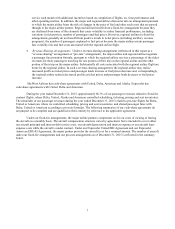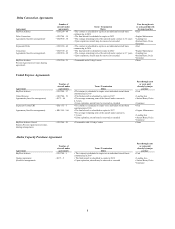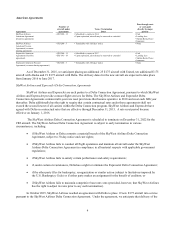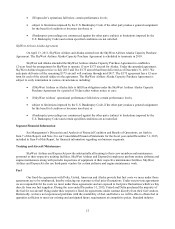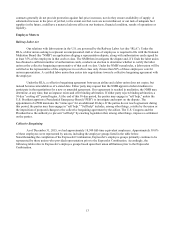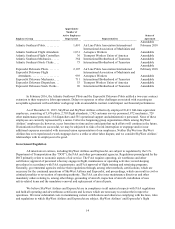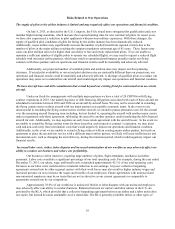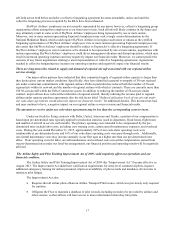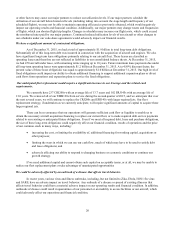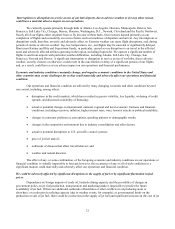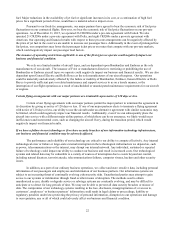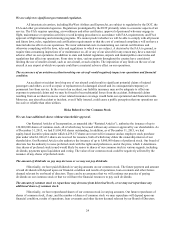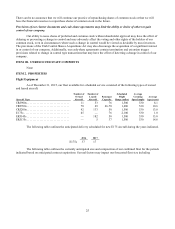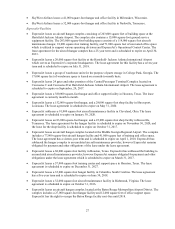SkyWest Airlines 2015 Annual Report Download - page 21
Download and view the complete annual report
Please find page 21 of the 2015 SkyWest Airlines annual report below. You can navigate through the pages in the report by either clicking on the pages listed below, or by using the keyword search tool below to find specific information within the annual report.17
self-help action both before and after a collective bargaining agreement becomes amendable, unless and until the
collective bargaining processes required by the RLA have been exhausted.
SkyWest Airlines’ employees are not currently represented by any union; however, collective bargaining group
organization efforts among those employees occur from time to time. Such efforts will likely continue in the future and
may ultimately result in some or all of SkyWest Airlines’ employees being represented by one or more unions.
Moreover, one or more unions representing ExpressJet employees may seek a single carrier determination by the
National Mediation Board, which could require SkyWest Airlines to recognize such union or unions as the certified
bargaining representative of SkyWest Airlines’ employees. One or more unions representing ExpressJet employees may
also assert that SkyWest Airlines’ employees should be subject to ExpressJet’s collective bargaining agreements. If
SkyWest Airlines’ employees were to unionize or be deemed to be represented by one or more unions, negotiations with
unions representing SkyWest Airlines’ employees could divert management attention and disrupt operations, which may
result in increased operating expenses and may negatively impact our financial results. Moreover, we cannot predict the
outcome of any future negotiations relating to union representation or collective bargaining agreements. Agreements
reached in collective bargaining may increase our operating expenses and negatively impact our financial results.
There are long-term risks related to supply and demand of regional aircraft associated with our regional airline
services strategy.
Our major airline partners have indicated that their committed supply of regional airline capacity is larger than
they desire given current market conditions. Specifically, they have identified a general oversupply of 50-seat regional
jets under contractual commitments with regional airlines. Delta in particular has reduced both the number of 50-seat
regional jets within its network and the number of regional airlines with which it contracts. There are currently more than
100 50-seat aircraft within the Delta Connection system. In addition to reducing the number of 50-seat jets under
contract, major airlines have reduced the utilization of regional aircraft, thereby reducing the revenue paid to regional
airlines under capacity purchase agreements (See the risk factor titled “Reduced utilization levels of our aircraft under
our code-share agreements would adversely impact our financial results” for additional details). This decrease has had,
and may continue to have, a negative impact on our regional airline services revenue and financial results.
The amounts we receive under our code-share agreements may be less than the corresponding costs we incur.
Under our fixed-fee flying contracts with Delta, United, American and Alaska, a portion of our compensation is
based upon pre-determined rates typically applied to production statistics (such as departures, block hours, flight hours
and number of aircraft in service each month). The primary operating costs intended to be compensated by the pre-
determined rates include labor costs, including crew training costs, certain aircraft maintenance expenses, and overhead
costs. During the year ended December 31, 2015, approximately 84% of our code-share operating costs were
reimbursable at pre-determined rates and 16% of our code-share operating costs were pass-through costs. Additionally,
our aircraft maintenance costs may increase annually as our fleet ages at a higher rate than our pre-determined rates
allow. If our operating costs for labor, aircraft maintenance and overhead costs exceed the compensation earned from
our pre-determined rates under our fixed-fee arrangements, our financial position and operating results will be negatively
affected.
The Airline Safety and Pilot Training Improvement Act of 2009 could negatively affect our operations and our
financial condition.
The Airline Safety and Pilot Training Improvement Act of 2009 (the “Improvement Act”) became effective in
August 2013. The Improvement Act added new certification requirements for entry-level commercial pilots, requires
additional emergency training for airline personnel, improves availability of pilot records and mandates stricter rules to
minimize pilot fatigue.
The Improvement Act also:
• Requires that all airline pilots obtain an Airline Transport Pilot license, which was previously only required
for captains.
• Obligates the FAA to maintain a database of pilot records, including records to be provided by airlines and
other sources, so that airlines will have access to more information before they hire pilots.


